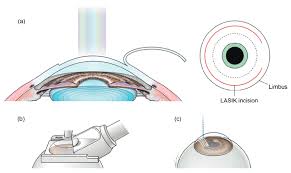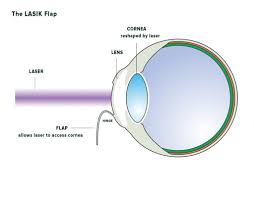Table of Contents
ToggleVision correction surgeries have been a beacon of technological advancement in the medical field, offering a life-changing escape from the mundanity of every day glasses and contacts for millions. One of these groundbreaking procedures is SMILE surgery — Small Incision Lenticule Extraction, known for its minimally invasive nature and rapid visual recovery.
However, what happens when your vision isn’t the crystal-clear, post-surgery utopia you had hoped for?
This blog post is dedicated to understanding and addressing the often confusing and alarming phenomenon of fluctuating vision post-SMILE surgery.
Unmasking Fluctuating Vision: A Post-SMILE Puzzle
Understanding your eyes’ behaviour after SMILE surgery is a crucial part of the patient’s postoperative experience. The human body, including your eyes, is remarkably adaptive, often taking time to adjust to new circumstances — such as a lighter lenticule post-SMILE surgery.
Vision fluctuation occurs when your eyes are still aligning with the new visual pathway, leading to periods of clarity and haziness. This fluctuation can manifest in various forms, including:
- Sudden Blurriness:
Clear vision one moment, a significant departure from that the next. - Glares and Halos:
Seeing starbursts around lights, especially at night. - Ghost Images:
Faint echoes of your primary visual target, disrupting a sharp focus. - Dry Eye-Induced Blurriness:
When dryness causes your vision to intermittently worsen.
The Science of SMILE Surgery and Visual Change
To best comprehend why vision may be in a state of flux, it’s essential to revisit the science behind SMILE surgery. During the procedure, a femtosecond laser carves a small, precise lenticule within the cornea, which is then removed through a small incision. This reshaping of the cornea creates a new visual pathway that your brain and eye muscles need to acclimate to fully.
The healing process post-SMILE includes:
- Corneal Incision Bonding:
The initial days after surgery are critical for this. Any disruptions can lead to visual inconsistencies. - Nerve Tissue Regeneration:
Ongoing after surgery, the nerves in the cornea play a role in tear production, and their renewal can temporarily affect your vision. - Corneal Edema:
Swelling of the cornea is a common side effect of the healing process, influencing the way light is refracted into the eyes. - Dryness and Tear Film Stability:
Reduced tear production can deteriorate the stability of your tear film, leading to temporary changes in vision quality. Understanding these physiological changes helps patients contextualise their vision fluctuations as part of the path towards stable, post-surgical vision.
Managing Fluctuating Vision at Home
While fluctuating vision can be unsettling, several at-home practices can aid in a smoother transition to consistent visual clarity. These include:
- Scrupulous Hygiene:
Maintain excellent hygiene to prevent any post-surgical complications, such as infections that can compromise your vision. - Scheduled Rest:
Follow the prescribed periods of rest for your eyes after surgery. This allows them to heal without strain. - Regular Use of Prescribed Drops:
Do not miss out on any of the postoperative medications and prescribed eye drops to keep your eyes sufficiently lubricated. - Nutritious Diet:
A well-balanced diet, rich in vitamins A and C, has been linked to better ocular health and can potentially expedite the healing process. - Avoiding Eye Rubbing:
It’s absolutely critical to avoid any rubbing or touching of the eyes, which can interfere with the healing of the corneal flap. Abiding by these practices can not only help reduce fluctuations but also accelerate healing, steering you towards a steady quality of vision.
When to Seek Help: Recognising the Line between Normal and Abnormal
While vision fluctuation is normal to an extent, there comes a point where these changes can indicate a more concerning issue. It’s crucial to differentiate between typical postoperative adjustments and complications that warrant professional intervention. Signs that you should seek immediate help include:
- Sudden or Severe Fluctuations:
Intense, brief periods of vision decline or changes that persist beyond the expected healing period can hint at underlying problems. - Excessive Pain:
Any pain, especially that which is not alleviated by over-the-counter medications, requires attention. - Redness or Discharge:
These could be signs of infection or inflammation. - Persistent Flares or Ghost Images:
If these disturbances do not diminish with the healing process, an optometrist or ophthalmologist should be consulted. Do not hesitate to contact your surgeon if in doubt. A thorough examination can rule out complications and set you on the right track to recovery.
Nurturing Patience and Perspective
The most valuable tool during the postoperative period is patience. Every fluctuation, discomfort, or moment of haziness is your body’s way of saying it’s still on the healing road. It’s not an overnight process, but with time and proper care, the majority of patients do achieve the stable, sharp vision they sought out through SMILE surgery.
Perspective is equally important. Remember that while you may experience fluctuations, the overarching trend should be towards improved vision quality. By keeping the end goal in sight and trusting the rehabilitation process, you can alleviate the stress that these vision changes may bring.
For the Prospective SMILE Patient
If you’re still considering SMILE surgery, understanding the full spectrum of the postoperative experience is integral to your decision-making process. Discuss with your surgeon the possible vision fluctuations and the likelihood of encountering them, as well as tailored advice for managing the post-op recovery to optimise your personal outcome.
Summing Up
Fluctuating vision is a common puzzle piece in the SMILE surgery narrative, often fitting together with time, care, and professional assistance. By demystifying the phenomenon and adhering to the recommended recovery practices, patients can turn their postoperative challenges into tales of triumphant visual success.
Remember, you’re not alone on this vision voyage. Your surgeon and countless others have walked this path and are committed to guiding you towards the clear, stable horizon you’ve envisioned. Your eyes have taken you this far in life — allow them the time and grace to adjust to this remarkable new chapter post-SMILE surgery.
Your vision may be fluctuating, but your path to informed, proactive eye health practices is steadfast and sure.













